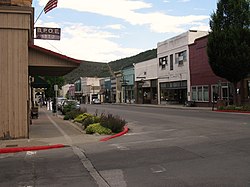This article needs additional citations for verification .(May 2025) |
Siskiyou County, California | |
|---|---|
| County of Siskiyou | |
Images, from top down, left to right: Mount Shasta, the historic West Miner Street in Yreka, Indian Tom Lake, Captain Jack's Stronghold in the Lava Beds National Monument, the McCloud River | |
| Motto: "Mountains of Opportunity" | |
 Interactive map of Siskiyou County | |
 Location in the state of California | |
| Coordinates: 41°35′N122°30′W / 41.583°N 122.500°W | |
| Country | United States |
| State | California |
| Region | Shasta Cascade |
| Incorporated | March 22, 1852 |
| Named after | The Siskiyou Trail |
| County seat | Yreka |
| Largest city | Yreka |
| Government | |
| • Type | Council–Administrator |
| • Chair | Nancy Ogren |
| • Vice Chair | Ray A. Haupt |
| • Board of Supervisors [1] | Supervisors
|
| • County Administrator | Terry Barber |
| Area | |
• Total | 6,347 sq mi (16,440 km2) |
| • Land | 6,278 sq mi (16,260 km2) |
| • Water | 69 sq mi (180 km2) |
| Highest elevation | 14,162 ft (4,317 m) |
| Population (2020) [3] | |
• Total | 44,076 |
• Estimate (2024) | 42,498 |
| • Density | 6.9/sq mi (2.7/km2) |
| GDP | |
| • Total | $2.008 billion (2022) |
| Time zone | UTC−8 (Pacific Time Zone) |
| • Summer (DST) | UTC−7 (Pacific Daylight Time) |
| Area code | 530 |
| FIPS code | 06-093 |
| GNIS feature ID | 277311 |
| Congressional district | 1st |
| Website | co |
Siskiyou County ( /ˈsɪskjuː/ ⓘ SISK-yoo) is a county located in the northwestern portion of the U.S. state of California. As of the 2020 census, the population was 44,076. [3] Its county seat is Yreka and its highest point is Mount Shasta. [5] It falls within the Cascadia bioregion. [6]
Contents
- History
- Geography
- Flora and fauna
- Adjacent counties
- National protected areas
- Transportation
- Major highways
- Public transportation
- Airports
- Politics
- Voter registration statistics
- Overview
- Crime
- Cities by population and crime rates
- Demographics
- 2020 census
- 2011
- 2010
- 2000
- Communities
- Cities
- Census-designated places
- Other unincorporated communities
- Ghost towns
- Population ranking
- See also
- Notes
- References
- Further reading
- External links
Siskiyou County is in the Shasta Cascade region along the Oregon border. Because of its outdoor recreation, Mt. Shasta, McCloud River, and Gold Rush-era history, it is an important tourist destination within the state.[ citation needed ]











